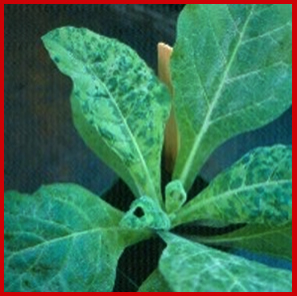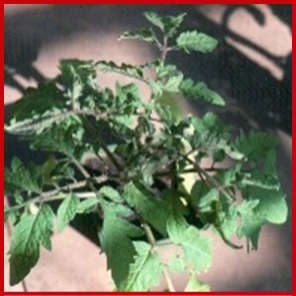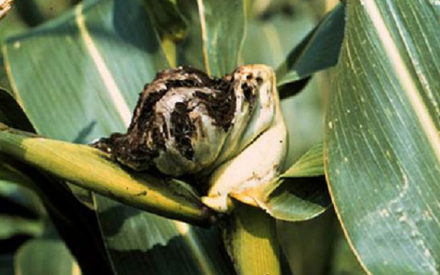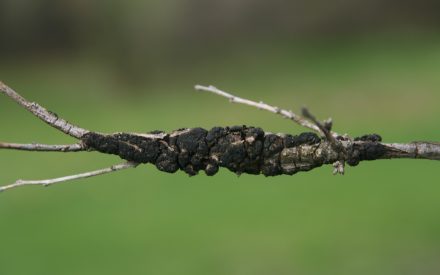
What is tobacco mosaic?
Tobacco mosaic is a common viral disease of worldwide distribution that affects over 200 species of herbaceous and, to a lesser extent, woody plants. Common hosts include tobacco, solanaceous vegetables (e.g., pepper, tomato) and vining vegetables (e.g., cucumber, melon, squash), as well as a wide range of ornamentals (e.g., begonia, coleus, geranium, impatiens, million bells, petunia). The disease has its biggest impact on vegetables, where it can reduce yield and affect quality to the point that commercial crops cannot be marketed.
What does tobacco mosaic look like?
Symptoms of tobacco mosaic vary in type and severity depending on the plant infected, plant age, the variant of the virus involved, and environmental conditions. On leaves, typical symptoms include blotchy light and dark areas (called mosaic); cupping, curling, elongation (strapping), roughening, wrinkling and other growth distortions; and smaller than normal size. Fruits may have a blotchy color, ripen unevenly, be malformed or have an off flavor. Entire infected plants are often stunted. Other viral diseases like cucumber mosaic can cause symptoms similar to tobacco mosaic. Often, multiple viral diseases can simultaneously affect a single plant. Certain herbicide exposures, nutrient deficiencies or toxicities, high temperature and even insect feeding can also cause similar symptoms. Proper diagnosis of tobacco mosaic requires lab testing.
Where does tobacco mosaic come from?
Tobacco mosaic is caused by Tobacco mosaic virus (TMV), the first virus ever identified. Numerous variants (strains) of the virus have subsequently been described. TMV survives in infected plants (including viable seeds), as well as in debris from these plants. Plant-based products (most notoriously tobacco products) can harbor the virus. TMV is very stable and can survive for long periods of time; there are reports of TMV surviving and remaining infectious after 50 years in storage at 40°F. Because of its stability, TMV can survive on and be picked up from hands, clothing, gardening tools, work surfaces and any other object (e.g., door knobs) that gardeners may handle.
TMV is highly transmissible and is commonly spread by handling infected plants, then healthy plants. Spread via gardening tools is also very common. No specific insects spread TMV (the way that aphids spread Cucumber mosaic virus). However, bees and chewing insects (e.g., grasshoppers) can transmit TMV through casual contact or their feeding as they move from plant to plant.

How do I save a plant with tobacco mosaic?
There is no cure for tobacco mosaic. Once infected, plants remain infected for life, and typically the virus spreads throughout the plant from the point of infection. Infected plants and any associated debris should be burned (where allowed by local ordinance) or double-bagged and disposed of in a landfill. Do not compost plants with this disease. Thoroughly decontaminate any items that have come into contact with infected plants or their debris by treating them for a minimum of one minute with:
- 2.75 tablespoons Alconox® (a lab detergent) plus 2.5 tablespoons sodium lauryl sulfate (SLS), also known as sodium dodecyl sulfate (SDS), in one gallon of water, or
- 14 dry ounces of trisodium phosphate in one gallon of water.
These ingredients can be ordered on the internet. If you decide to use SLS (SDS), be sure to wear gloves, safety goggles and a dust mask, and mix the solution in a well-ventilated area as SLS (SDS) is a known skin and eye irritant. Once treated, rinse items with sufficient water to remove any residues. Also, thoroughly wash your hands with soap and water, and launder any clothing that you wore while disposing of infected plants and debris.
How do I avoid problems with tobacco mosaic virus in the future?
Inspect plants prior to purchase for any symptoms of tobacco mosaic, and do not buy symptomatic plants. Purchase seed from a reputable supplier that routinely inspects their seed-producing plants for symptoms of viral (and other) diseases. If you use tobacco products, do not use them around plants. Also, wash your hands thoroughly with soap and water prior to handling plants, and consider wearing freshly laundered clothing when gardening. Finally, decontaminate (as described above) any items that might harbor TMV to help prevent spread. Even if you do not use tobacco products, routine handwashing and decontamination of gardening tools and other items can help prevent tobacco mosaic from being a problem.
For more information on tobacco mosaic:
Contact the University of Wisconsin Plant Disease Diagnostics Clinic (PDDC) at (608) 262-2863 or pddc@wisc.edu.
Authors: Sue Lueloff and Brian Hudelson, UW-Plant Pathology
Last Revised: 03/02/2024
D-number: D0115
References to pesticide products in this publication are for your convenience and are not an endorsement or criticism of one product over similar products. You are responsible for using pesticides according to the manufacturer’s current label directions. Follow directions exactly to protect the environment and people from pesticide exposure. Failure to do so violates the law.
Thanks to Brenda Dahlfors, Tom German, Jenna LaChance and Diane Lorenz for reviewing this document.
A complete inventory of UW Plant Disease Facts is available at the University of Wisconsin-Madison Plant Disease Diagnostics Clinic website: https://pddc.wisc.edu.
Send a Plant Sample for Analysis
Be cautious when self-diagnosing plant health issues. Very few diseases can accurately be diagnosed by eye.
Contact the UW Plant Disease Diagnostics Clinic (PDDC), and for a small fee, clinic staff can examine a plant, determine the cause of the disease/disorder, and provide advice on how to control or prevent the issue.
Download Article





 Vegetable Disease Quick Reference
Vegetable Disease Quick Reference Powdery Scab
Powdery Scab Tizón Tardío (Late Blight)
Tizón Tardío (Late Blight) Strategies for Identifying and Managing Plant Diseases
Strategies for Identifying and Managing Plant Diseases


